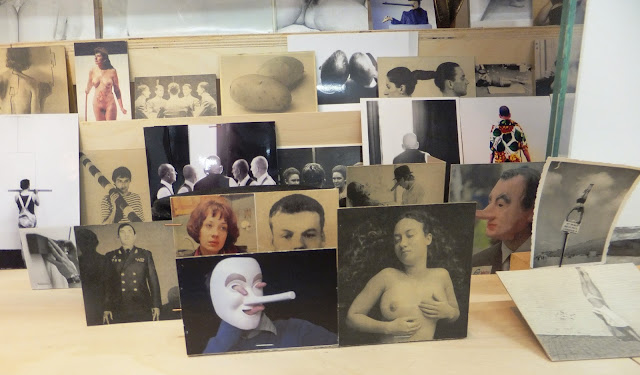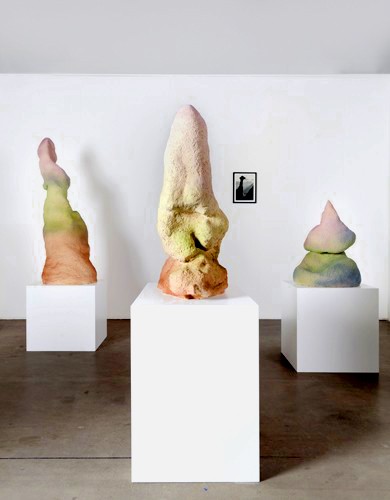 |
| Charl van Ark: Company 1994-2013 (detail) |
Rotterdam makes a sensible alternative to Amsterdam as a
base for seeing Dutch art: Schiedam and The Hague, which lie at two of the end
points of the straightforward underground system, both have vibrant galleries
of their own; and Amsterdam itself is only 35 minutes away by surprisingly
affordable high speed train (oddly enough, although house prices are probably
only half in Rotterdam, I was told that commuting from there to Amsterdam remains rare).
And the Dutch speak such good English that I stopped checking they could after
a couple said they couldn’t – they were, of course, joking.
Moreover, having been obliterated in World War II, Rotterdam seized the
chance to become a wholly modern architectural experience. That gives it a
radical and distinctive atmosphere – just what you want to feed into its
increasingly well-regarded Art Rotterdam Week (7-10 February).
Fashion and design are very much part of the scene too, with
the first European stop of a major Jean Paul Gaultier show opening at the
impressive Kunsthalle. The city’s trunks were bound in blue and white striped
corsets, like fetish version of tree rings, in recognition of that. The most striking feature of the exhibition wasn't so much the clothes as the use of video-projected faces on the mannequins wearing them. Gaultier
himself was in affable form, though the fashion journalists I met were unimpressed
by his own choice – below jeans and what was thought a rather fetching leather
skirt – of black Uggs... Small wonder, perhaps, that I
was drawn among the following to several works which echoed aspects of architecture, design and fashion in
the increasingly open-ended field of art…
 |
The Art Rotterdam fair itself is of manageable size (75 galleries) and has a relaxed atmosphere, a coherent aesthetic (emphasising Dutch minimalist traditions) and doesn’t go in for many ‘wow factor’ signature works – that was left to the city’s buildings and Art Warehouse – one of several patchy satellites, but bigger than the main fair! The moving image was mostly restricted to the separate, but linked, ‘Projections’ fair in a hotel opposite: 19 films shown on cinematic screens with headphones for sound in an concertina arrangement which made very effective use of space. So here are some highlights from Art Rotterdam, two imaginative interventions from the Warehouse, a choice from the significant amount of activity parallel to the fairs, and my impressions from quick trips to Schiedam and The Hague. Throw in a couple of parties, and there’s certainly enough for a busy weekend!
Stephen Balkenhol:
Tripod Man at Akinci (Amsterdam) in Art
Rotterdam
Gareth Moore: Bouvard and Pécuchet’s Invented Desk for
Copying at Torri (Paris) in Art Rotterdam
My favourite piece of gallerists’ furniture was this desk: Flaubert
meets Judd in the ninth in New York
based Canadian artist Gareth Long’s ongoing series of imagined designs of a
desk to suit the copy clerks Bouvard and Pécuchet. The first half of the novel
ends with their preparations to construct a two-seated desk at which to make copies:
the second half was to consist of what they copied, but Flaubert suffered the
unrepeatable fate before he could write it. The desk itself was copied from
plans locally rather than shipped to Rotterdam,
as suited the straightforward pine construction of conceptual furniture.
Folkert de Jong: Act of Despair at Galerie Fons Welters (Amsterdam) in Art
Rotterdam
Whereby the Dutch artist known for sardonic
historical figure groups made from the ethically and practically challenging
material of Styrofoam switches to a still life in traditional bronze, albeit
some of it’s painted to look like disposable foam cups. The title suggests a self-deprecating
self-portrait of sorts: the circus balls read across to the juggling required
to make art decisions, and the teetering architecture of the cups making the
likelihood of failure clear enough. .
Navid Nuur: When doubt turns into destiny, 1993-2010
at Martin von Zomereren (Amsterdam )
in Projections
You might say there are two main ways to go with video art:
an instant idea with the resonance to carry rich interpretation, or narrative
invention and deconstruction. The ‘Projections’ fair fielded a powerful example
of the former in the trenchantly artificial form of Erkka Nissinen’s ‘Polis X’,
but its easier to transmit the impact of Navid Nuur’s ‘When doubt turns into
destiny’, even though it runs for twenty five minutes across three screens
simultaneously. In each, we see the artist in Eindhoven ’s back alleys by night, attempting
to move slowly enough that he doesn’t trigger the security lights. Every now
again he does, and freezes. Quite apart
from proving a succinct metaphor for Nuur’s general desire to ‘mediate between
thoughts and their materialisation’, it’s rather funny. Will you be able to see
it in the Teheran-born Dutchman’s overdue first major British show (Parasol
Unit, 13 March – 26 May)? Maybe, but he’s so productive every which way I won’t
be surprised if he’s moved on by then…’
Bettina Buck: Interlude at Rokeby Gallery (
Were Nuur brings conceptualism to the city, Bettina Buck
brings minimalism to the countryside with equal economy, resonance and wit. In the
five minute Interlude, we follow the German sculptor labouring across the
somewhat ominous cliff-top grassland of the notorious suicide spot Beachy Head . She’s carrying, in various uncomfortable wind-buffeted
ways, a coffin-sized block of foam which weighs about what she does. At least
it’s good to rest on when she tires…
Charl van Ark: Company 1994-2013 at Phoebus (Rotterdam)
in Art Rotterdam
Made in parallel with his primary stream of abstracts, Dutch painter Charl van Ark’s take
on the cabinet is essentially a twenty year 3-D scrapbook of memories and
inspirations. That’s not particularly novel in itself, though the fashionable
Geoffrey Farmer’s similar aesthetic came later. Van Ark,
however, has a winning light touch in how he selects and juxtaposes the
personal, the art historical and the mainstream to keep the viewer moving
across its teeming contents: potatoes and heads, art uses of sticks, a
photographed trapezist given a real rope in an echo of Joseph Kosuth, Nauman
as fountain matched with a pisseur
etc...
Salvatore Arancio at Frederico Schiavo Gallery (Rome ) in Art Rotterdam
(New Art Section)
The taller of these curious ceramics with some of Rotterdam ’s architectural thrust are psychedelic version
of a ‘lava trees’ from Hawaii
Kim de Ruysscher at Art Warehouse
Young Belgian artist Kim de Ruysscher was a significant
presence on both floors of the Art Warehouse with work which yet pushed further
in the well-explored territory of material transformation. Downstairs, he himself – having won the right
to a stand - was revealing to all comers that the
canvases, tubes of paint, packaging, rusting iron implements and plenty else
displayed on contrastingly light polystyrene stands were actually made from various
stones, cunningly chosen to maximise
particular effects. Upstairs, he showed giant nuts and bolts made principally
of coffee – the useful rendered dysfunctional, and oddly olfactory, by scale
and substance.
Mitsy Groenendijk at Art Warehouse
I suspect most visitors will have missed Mitsy Groenendijk’s
installation, which was visible only through a small window into an ante-room
halfway up the stairs. That, of course, made it all the more startling if you
did discover three monkeys hidden away in the manner of illegal immigrants, of
which they could be the ultimate example – appropriately enough in Europe ’s largest port. They were child-sized, semi-anthropoid,
covered in human hair. Amsterdam-based Groenendijk specialises in such primate
figures, which tread a provocative line between sweet and repulsive, endearing
and mawkish while implying some sort of challenge to our evaluation of the
merits of evolution.
Paola Pivi: Tulkus 1880 to 2018 at the Witte de With Center for Contemporary Art
Jan Maarten Voskuil: 'Pointing Inside' at the Stedelijk Museum, Schiedam
The Stedelijk Museum Schiedam is highly distinctive: four floors spread across
two wings and accessible - prior to a forthcoming redevelopment - only
via the basement in somewhat jocular style. The several current shows include highlights from its own astutely-purchased collection of early COBRA works; the large, meditative
charcoal on coloured paper drawings of Rotterdam-based Indian Aji V.N; and an
extensive presentation of the radical work of Jan Maarten Voskuil,
who paints on linen which is applied around bent frames so that circular image
appears as a square of sorts. He hasn't painted 'flat' since 2001, and has
explored the vast range of constructions from this initial idea, including - in Painting Inside II - the deepest painting I've ever seen.
 |
| Bridget Riley: Two Yellows Composition with Cricles 4, 2011 |
Bridget Riley at the Gemeentemuseum Den Haag
The Hague, famous for its international courts, is an historic town with several museums, including the
extensive Gemeentemuseum Den Haag. Its highlights included a thematic display demonstrating an imaginative policy of recent acquisitions (eg major installations of Kari Upson and Charles Avery), and solo shows by two British
artists: Karla Black's first such in the Netherlands - a vast
cellophane construction alongside work as insubstantial as smears on
the windows and powder on the walls; and a room of Bridget Riley in the context of a thorough survey of De Stijl, which pivots around the world's largest collection of Mondrian
paintings. This recent use of circular yellows was neatly paired with the classic 'White Discs 2' from 1964.
Images courtesy of relevant galleries and artists and Aatjan Renders (de Jong)














No comments:
Post a Comment
Note: only a member of this blog may post a comment.